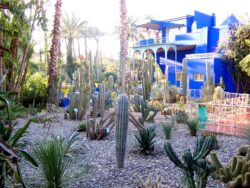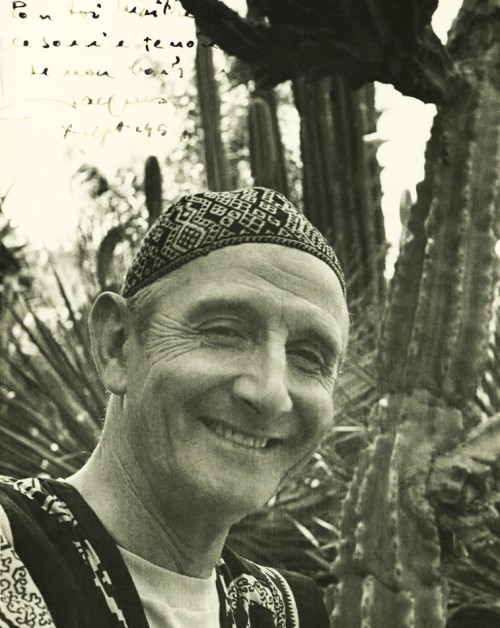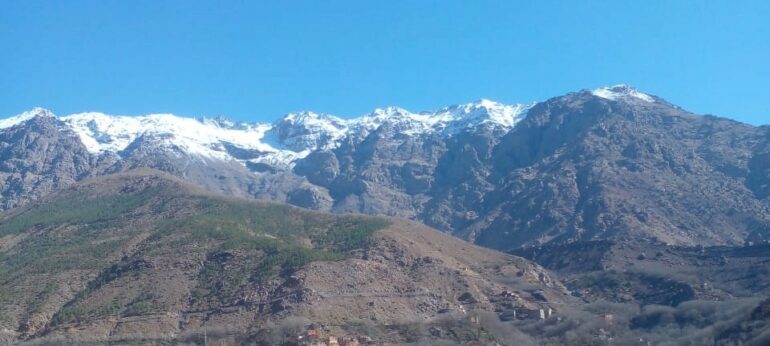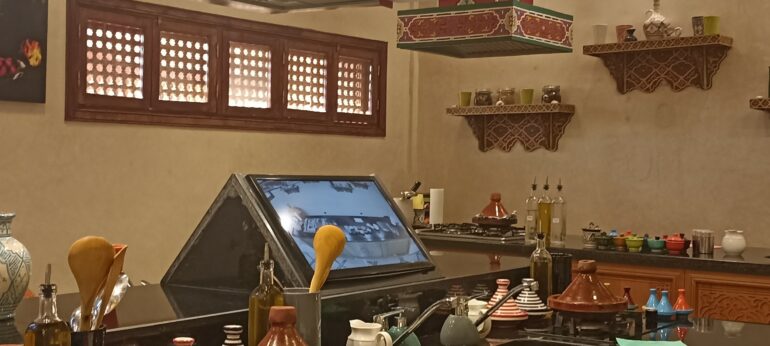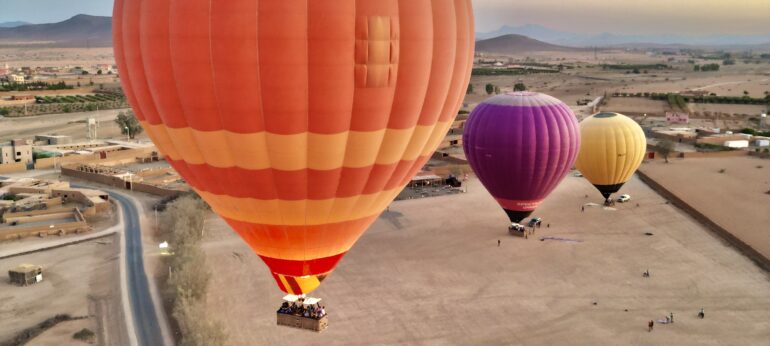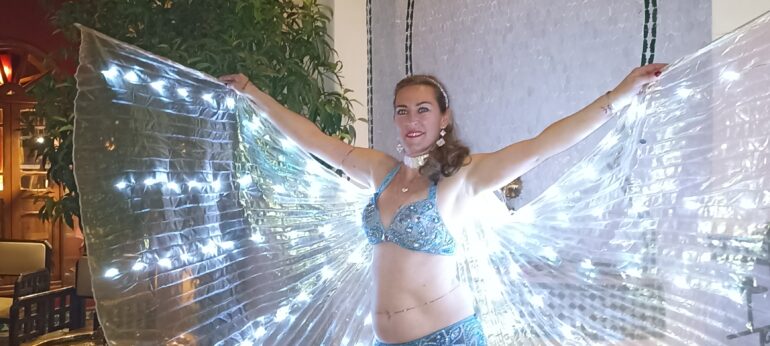“Majorelle”
“Majorelle”, of course, this name rings a bell and you finally see with your eyes the intense ‘Majorelle blue’!
Yet, when we talk about this garden, we think of Yves Saint-Laurent, the well-known French fashion designer, who died in 2008. His memorial stands now in a corner of the park.
Obviously the artist Jacques Majorelle (1886-1962) is less famous than his eponymous garden and blue color. Although considered by specialists as a major painter in his artistic movement his name is still not universally recognized.
Orientalism
In the 17th century Molière already made fun of the Mamamouchi’s (Monsieur Jourdain) “turqueries”, but the impact of Napoleon’s Egyptian campaign and the conquest of Algeria by 1830 will impose the Orient as a recurring theme in the Western literature and visual arts.
For the artists, that means a salutary renewal of the subjects, the discovery of untraveled landscapes, scenes of swarming and colourful crowds, liberated sensuality, the fascination for the desert and for the mysterious harem… and fantasy stimulated by the stories of the settlers.
Technically, colors, perspectives and contents change and show a different aesthetic very much in vogue again in the 20th century. Its most illustrious representatives include Eugène Delacroix, , Dominique Ingres, Henri Regnault or Eugène Fromentin.
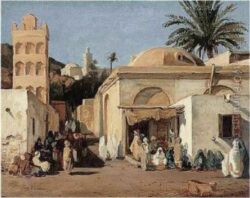
Jacques Majorelle was born in Nancy in 1886, son of the famous decorator and furniture designer Louis Majorelle, one of the distinguished founders of the Ecole de Nancy with Emile Gallé. The Art Nouveau style has no secrets for him. He began studying architecture, but he chose painting as a mode of expression.
His travels will nourish his mind and works.
Spain, Italy, Venice… and then in 1910, he discovers Egypt, stayed there a few years, and arrives in Morocco in 1917.
Love at first sight for Marrakech where he decides to settle permanently with his wife. From 1921, he explores, travels across the country, including the South, takes many pictures, he writes:
« More and more wild mountains. Mineral landscapes are interrupted around the villages by clumps of almond trees. These flowers in this desert! What a strange vision. By far trees seem to be powdered or frosted. We walk on the shadows of flowers which lose their nacreous petals on the pebbles of the path. I’m going through a succession of natural circuses, their whimsical ridges seeming to be drawn by an alcoholic. »
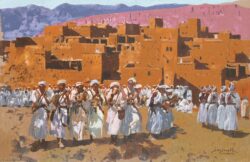
He observes:
‘How amazing are the visions of these colorful groups of people, gathered on the square, in the streets and in the courtyards of the houses, on the stairs and on the terraces. Women, wearing large spotless white dresses and scarves in screaming colours, move like puppets in front of the dark tone of the houses and the mountains. The sky is red-purple and the only light in this scene comes from these white people… »
He starts to paint.
For that purpose he gathers enough stuff to be able to publish travel stories under the title ‘Road trip diary of a painter in the Atlas and the Anti-Atlas’ and shows a series of paintings exhibited in Paris in 1922 and in Casablanca in 1929. From 1930 he develops a new theme, that of the naked black women, exhibited in Paris in 1934. After the Second World War, he also travels across Black Africa, and finds there another topic of creativity.
As a decorator, we can see the influence of his father but his personal language is marked by the formal traditions of the Berber culture.
He opens handicraft workshops in Marrakech, using different materials, and is involved in various projects for the hotel La Mamounia, the lobby of the Moroccan Pavilion for The International Exhibition of Modern Decorative and Industrial Arts in Paris 1925 and focuses on the development of his Bou SafSaf villa. Its construction had started in 1923 on a land he had just acquired and gradually extended
The artist’s Studio Pavilion will be completed in 1933 with the collaboration of the architect Paul Sinoir.
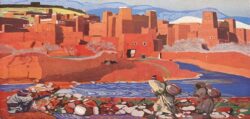
Botany
Jacques Majorelle is passionate about this science.
The garden of his property will prove to be his masterpiece.
He will collect and import trees and plants from around the world. Then he will compose his largest painting over time.
He creates its harmony, lights and shadows for his cherished palm trees, bamboo, hibiscus, Cypress, geraniums, willows, Gaboon, bougainvillea, carob trees, agaves, jasmines, laurels, and water lilies… and thousand cacti. He draws the flowerbeds and alleys, then he creates contrasts with this so deep cobalt blue, we call nowadays the Majorelle Blue.
In a visionary manner he claims ” “. This garden is a terrible task, to which I entirely devote myself. It’ll take me my last years and I’ll fall exhausted under its branches after having given all my love. »
But the game is expensive! In 1947, the garden has to be opened to the public with an admission fee.
The ups and downs of a life as an artist, financial difficulties, divorce and serious accidents will undermine his will. His property will be partly sold and the artist died in Paris in 1962. He is buried in Nancy, near his father.
The willow trees will really weep because the garden is dying too.
Just a few sad souls come to visit it.
In 1980 Yves Saint-Laurent and Pierre Bergé discover it and buy it with the house, saving it from oblivion and from total disappearance that a hotel project would have caused.
And this marks the beginning of a beautiful rebirth and a new chapter for the extraordinary garden.
Already another story, at the crossroads between history and personal destinies.
The Majorelle garden
Already another story, at the crossroads between history and personal destinies.
The contrast is striking. As soon as you walk through the Garden Gate, you leave behind the chaotic noise of the city. Silence immediately imposes itself. Only a few birds’ chirps and the gentle water lapping seem to rock the place. It is imbued with calm which is naturally respected by everyone.
Even the groups of tourists, walking slowly, speak in a low voice.
The children, who might be tempted to run in the alleys seem to be seized by the same bewitching charm.
This symphony of green and blue resonates, bringing appeasement in the souls.
